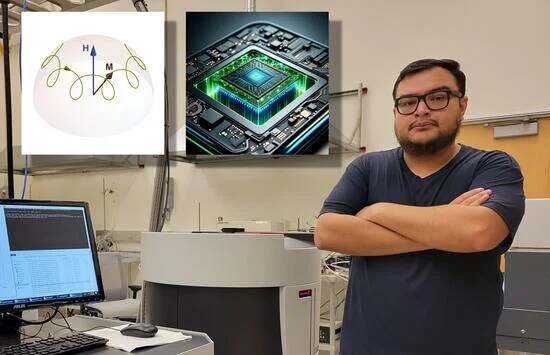THE LATEST
Propelling ferromagnets into the realm of ultra-fast communication, computation tech

A team of researchers at the University of California, Riverside, has made a significant breakthrough in understanding and utilizing ultra-fast spin behavior in ferromagnets. This research, featured in Physical Review Letters, opens the door for the development of high-frequency applications that could revolutionize future communication and computation technologies.
Currently, smartphones and computers operate at gigahertz frequencies, but there is a push to make them even faster. This research suggests that it may be possible to achieve terahertz frequencies using conventional ferromagnets, which could lead to communication and computation technologies operating at speeds a thousand times faster than current benchmarks.
Ferromagnets, which have electrons with aligned spins, exhibit a phenomenon called "spin waves," which are crucial for processing information and signals in emerging computer technologies.
Dr. Igor Barsukov, an associate professor of physics and astronomy at UC Riverside, explained that the interaction of electron spins with electrons and the crystal lattice of ferromagnets causes them to experience friction. This friction leads to the acquisition of inertia by the spins, resulting in an additional form of spin oscillation called nutation, which occurs at ultra-high frequencies and holds great promise for future computer and communication technologies.
The study also highlighted the potential of nutational auto-oscillations generated by injecting a spin current with the "wrong" sign, as explained by the first author of the paper, a graduate student in the Barsukov Group and scientist at HRL Labs, LLC.
Coauthor Allison Tossounian, previously an undergraduate student in the Barsukov Group, recognized the promise of these self-sustained oscillations for the next generation of computation and communication technologies.
Dr. Barsukov emphasized the impact of introducing a second-time derivative in the equation of motion by spin inertia, leading to the emergence of counterintuitive phenomena. By harmonizing spin-current-driven dynamics and spin inertia, and identifying similarities between the spin dynamics in ferromagnets and ferrimagnets, the study could accelerate technological innovation by leveraging synergies between these fields.
Additionally, Dr. Barsukov highlighted the growing interest in ferrimagnets, which have two antiparallel spin lattices with an unequal amount of spin, as potential candidates for ultrafast applications.
While acknowledging ongoing technological challenges, Dr. Barsukov pointed out significant advances in understanding spin currents and materials engineering for ferromagnets over recent decades. These developments, combined with the confirmation of nutation, have paved the way for ferromagnets to emerge as leading contenders for ultra-high frequency applications.
The study, titled "Spin inertia and auto-oscillations in ferromagnets," received support from the National Science Foundation.
